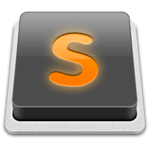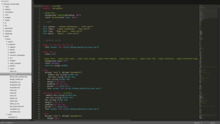Sublime Text
 | |
| Developer(s) | Jon Skinner |
|---|---|
| Initial release | 18 January 2008 |
| Stable release |
2.0.2
/ 8 July 2013 |
| Preview release |
3 development build 3126 (public beta)
/ 23 September 2016 |
| Development status | Active[1] |
| Written in | C++, Python |
| Operating system | Linux 32/64-bit, Mac OS X 10.6 or later (version 2), 10.7 or later (version 3), Microsoft Windows 32/64-bit |
| Size | ~5–8 MB |
| License | Proprietary software,[2] Nagware |
| Website |
www |
Sublime Text is a proprietary cross-platform source code editor with a Python application programming interface (API). It natively supports many programming languages and markup languages, and its functionality can be extended by users with plugins, typically community-built and maintained under free-software licenses.
Features
The following is a list of features of Sublime Text:[3]
- "Goto Anything," quick navigation to files, symbols, or lines
- "Command palette" uses adaptive matching for quick keyboard invocation of arbitrary commands
- Simultaneous editing: simultaneously make the same interactive changes to multiple selected areas
- Python-based plugin API
- Project-specific preferences
- Extensive customizability via JSON settings files, including project-specific and platform-specific settings
- Cross platform (Windows, OS X, Linux)
- Compatible with many language grammars from TextMate
Version 2
Sublime Text 2.0.2, the current release, was released on 8 July 2013. Changes from the first version of the software as promoted by Skinner on the official Sublime blog include Retina display support and "Quick Skip Next" functionality."[4]
Interface

Themes
- Sublime Text contains 22 different visual themes, with the option to download additional themes and configure custom themes via third-party plugins.
- The minimap feature shows a reduced overview of the entire file in the top-right corner of the screen. The portion of the file visible in the main editor pane is highlighted and clicking or dragging in this view scrolls the editor through the file.[5]
Panels, groups and screen modes
- The program offers a number of screen modes including panels that can show up to four files at once as well as full screen and distraction free modes which only show one file without any of the additional menus around it.
Features
- Column selection and multi-select editing
This feature allows users to select entire columns at once or place more than one cursor in text, which allows for simultaneous editing. All cursors then behave as if each of them was the only one in the text. Commands like move by character, move by line, text selection, move by words, move by subwords (CamelCase, hyphen or underscore delimited), move to beginning/end of line etc., affect all cursors independently, allowing one to edit slightly complex repetitive structures quickly without the need to use macros or regex.[6]
- Auto completion
Sublime Text will offer to complete entries as the user is typing depending on the language being used. It also auto-completes variables created by the user.
- Syntax highlight and high contrast display
The dark background on Sublime Text is intended to reduce eyestrain and increase the amount of contrast with the text.
- In-editor code building
This feature allows users to run code for certain languages from within the editor, which eliminates the need to switch out to the command line and back again. This function can also be set to build the code automatically every time the file is saved.
- Snippets
This feature allows users to save blocks of frequently used code and assign keywords to them. The user can then type the keyword and press tab to paste the block of code whenever they require it.
- Goto anything
This feature is a tool that allows users to switch between open, recent or project files and also navigate to symbols within them.[7]
- Other features
Sublime Text has a number of features in addition to these including:[8]
- Auto-save, which attempts to prevents users from losing their work
- Customizable key bindings, a navigational tool which allows users to assign hotkeys to their choice of options in both the menus and the toolbar.
- Find as you type, begins to look for the text being entered as the user types without requiring a separate dialog box.
- Spell check function corrects as you type.
- Macros.
- Repeat the last action.
- A wide selection of editing commands, including indenting and unindenting, paragraph reformatting and line joining.
Package manager
Package Control is a third-party package manager for Sublime Text which allows the user to find, install, upgrade and remove plug-ins, usually without restarting Sublime Text. The package manager keeps installed packages up-to-date with an auto-upgrade feature and downloads packages from GitHub, BitBucket and a custom JSON-encoded channel/repository system. It also handles updating packages cloned from GitHub and BitBucket via Git and Hg, as well as providing commands for enabling and disabling packages. The package manager also includes a command to bundle any package directory into a .sublime-package file.[9]
Notable third-party packages include:
- SublimeCodeIntel — Features include Jump to Symbol Definition, Function Call Tool-Tips.[10]
- Sublime Goto Documentation — Opens relevant documentation for the highlighted function.
- Bracket Highlighter — Enhances the basic highlights Sublime Text provides for bracket pairs.
- Sublime dpaste — Sends selected text to the dpaste.com service.
- SublimeLinter — Code linting (validation) for JavaScript, Perl, PHP, Python, Ruby, and others.
- Side Bar Enhancements — Enhancements to the Sublime Text 2 sidebar with new options for deleting, opening, moving, creating, editing, and finding files.
- ColorSublime — Expands the number of Themes available from the standard 22 to over 250 community-submitted color schemes[11]
- WordPress — Adds autocompletion and Snippets for the blogging platform WordPress
- Git — Integrates Git functionality into Sublime Text
Version 3
Version 3 entered beta on 29 January 2013. At first available only for registered users who have purchased Sublime Text 2, on 28 June 2013 it became available to the general public. However, the very latest development builds still require a registration code.[12]
Two of the main features that Sublime Text 3 adds include symbol indexing and pane management. Symbol Indexing allows Sublime Text to scan files and build an index to facilitate the features Goto Definition and Goto Symbol in Project. Pane Management allows users to move between panes via hotkeys.[13]
Sublime Text 3 is very stable, as of 22 March 2016, about 80% of those using Package Control are running version 3[14] and Sublime Text 3 is the default download version on its website.[15][16]
See also
- List of text editors
- Comparison of text editors
- Popular replacements and main competitors: Atom, BBEdit, TextMate, Notepad++, Emacs, vim, Brackets, Visual Studio Code, and others.
References
- ↑ "Development Status - July 2014".
- ↑ "Sublime Text 2 EULA". Sublime HQ Pvt Ltd.
- ↑ "Sublime Text". Sublime HQ Pty Ltd. Retrieved 14 March 2014.
- ↑ "Sublime Blog". Retrieved 11 April 2015.
- ↑ "Interface". 1stwebdesigner. Retrieved 13 November 2012.
- ↑ "Features". makeuseof.com. Retrieved 13 November 2012.
- ↑ "Features". thewebdesignbay.com. Retrieved 13 November 2012.
- ↑ "Features". 1stwebdesigner. Retrieved 13 November 2012.
- ↑ "Package Control". wbond.net. Retrieved 9 September 2013.
- ↑ "Package Manager". rockettheme.com. Retrieved 26 November 2012.
- ↑ "Colorsublime". Colorsublime.com. Retrieved 11 April 2015.
- ↑ "Sublime Text 3 Dev Builds". Retrieved 9 September 2013.
- ↑ "Sublime Text 3 Beta". Sublime Blog. Retrieved 11 January 2014.
- ↑ Bond, Will. "Sublime Text 2 not developed anymore?". Sublime Text Forum. Retrieved 22 June 2016.
- ↑ FichteFoll. "Sublime Text 2 not developed anymore?". Sublime Text Forum. Retrieved 22 June 2016.
- ↑ "Sublime Text: The text editor you'll fall in love with". Sublime Text. Retrieved 22 June 2016.
